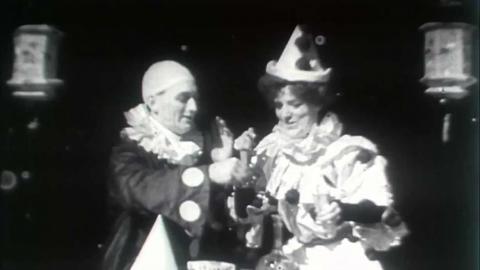This film is part of Free

Two Clowns
A showcase for GA Smith’s patented Kinemacolor process, based around a suitably colourful subject
Overview
Experiments with colour film date back to the dawn of cinema itself, but one of the more technically successful early examples was Kinemacolor, patented in 1909 by George Albert Smith (1864-1959) after years of tests. Visually, this film is similar to the comic 'facials' that Smith helped pioneer in the late Victorian era, but the decision to use clowns (one played by his wife Laura Bayley) gave him the opportunity to display and control the colours that registered best with the system: red and green.
A former stage mesmerist, Smith knew that he could fool the viewer into perceiving colours that weren’t there, so by shooting alternate frames through red and green filters and projecting them the same way, he achieved a remarkably effective simulation, at least to viewers who had yet to experience Technicolor and its successors. Smith’s biggest technical challenge was to create a film stock that would be sufficiently sensitive to the whole colour spectrum. Existing orthochromatic film was fine for black and white, but proved unsuitable for anything else, especially where reds were involved.
Related

Something Completely Different Something Completely Different
1974 4 mins Silent Location: Doune
Join John Cleese and the cast of Monty Python and the Holy Grail on location in Scotland

Miranda Miranda
Comedy 1948 80 mins
A man goes fishing and comes home with a most unusual catch in this comedy feature.

Is This a Record? Is This a Record?
Animation & Artists Moving Image 1973 22 mins
Pythons join Frank Muir, Connie Booth and Willie Rushton celebrating the Guinness Book of Records.

Shooting Stars Shooting Stars
Comedy 1937 32 mins
Black music hall stars Scott and Whaley perform stereotypical minstrel routines in blackface in this 1937 touring revue.

Le Petomane Le Petomane
Comedy 1979 33 mins
The immortal Leonard Rossiter makes flatulence a fine art in this short, poignant comedy-drama from Hancock writers Galton and Simpson

Arthur? Arthur! Arthur? Arthur!
Comedy 1969 101 mins Location: Camden
A hen-pecked inventor plots murder while he leads a bizarre double life as a bewigged playboy who runs a dating agency

New Perspectives: Nosferatu: A Symphony of Horror New Perspectives: Nosferatu: A Symphony of Horror
Short documentary 2025 3 mins
Harry Coghlan of Northumbria University explains why FW Murnau's 1922 vampire story is an endlessly intriguing work of art.

New Perspectives: La Haine New Perspectives: La Haine
Short documentary 2025 4 mins
Charlie Hammersley, a student from Northumbria University, explains how Mathieu Kassovitz's 1995 film holds up a mirror to society.

Dreamers Q&A Dreamers Q&A
Inside Film 2025 30 mins
The film-makers behind a haunting tale of love and community within a UK immigration detention centre visited the BFI Southbank to discuss their film.

Paul Thomas Anderson and Leonardo DiCaprio in Conversation Paul Thomas Anderson and Leonardo DiCaprio in Conversation
Inside Film 2025 50 mins
Paul Thomas Anderson and Leonardo DiCaprio in Conversation at BFI Southbank, discussing the making of One Battle After Another.

Laura Mulvey in Conversation Laura Mulvey in Conversation
Inside Film 2025 76 mins
Laura Mulvey in conversation, following her BFI Fellowship Award.

George Clooney in Conversation George Clooney in Conversation
Inside Film 2025 74 mins
George Clooney visited BFI Southbank to look back on his life and career.